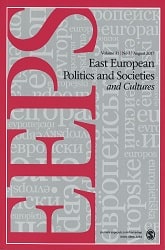From Revolutionary to Clientelistic Party: The Communist Party of Yugoslavia, 1945–1952
From Revolutionary to Clientelistic Party: The Communist Party of Yugoslavia, 1945–1952
Author(s): Marija ObradovićSubject(s): Political history, Government/Political systems, WW II and following years (1940 - 1949), Post-War period (1950 - 1989), History of Communism, Sociology of Politics
Published by: SAGE Publications Ltd
Keywords: Communist Party of Yugoslavia; Tito’s Politburo; “people’s democracy”; worker-peasant class; clientelism; nomenklatura;
Summary/Abstract: Recent reinterpretations of the history of socialist Yugoslavia, which broke up at the time of the collapse of communism in Eastern Europe (1989–1991), have revived old and opened new controversies concerning the character and policy of the Communist Party of Yugoslavia (KPJ) at the time of the establishment of the Federal People’s Republic of Yugoslavia (FNRJ) following the Second World War. One of them credits the “absolutization” of Josip Broz Tito’s charisma for the establishment and functioning of KPJ rule. The main aim of this article is to challenge such claims by providing an analytical account of the formative years of socialist Yugoslavia based upon primary archival sources. These sources illustrate that rather than Tito’s omnipotence, the decisive factor in the functioning of KPJ power was the clientelistic structure of hierarchical party and state organization. This paper argues that the establishment of clientelistic group-rational behavioral patterns in the KPJ structure and state organization drove the institutionalization of loyalty between the patron, the Politburo of the Central Committee of the KPJ (KPJ CC Politburo), and the client, the communist nomenklatura, an organized social network of party cadres occupying all significant functions in the society. The social origin of the members of the nomenklatura, that is, the new worker-peasant class organized at the level of federal units, was the basis for the legitimacy and functioning of KPJ power from 1945 through 1952. The revolutionary authority of the KPJ, which had been won through the partisan anti-fascist people’s liberation struggle during the Second World War, legitimized itself in this period through clientelistic structural dynamics in the political system of a “people’s democracy.” In order to explore these arguments, this article applies a generic-structural historical analysis to the dynamics of the social and political KPJ structures in 1945–1952 Yugoslavia.
Journal: East European Politics and Societies
- Issue Year: 27/2013
- Issue No: 03
- Page Range: 376-399
- Page Count: 24
- Language: English
- Content File-PDF

